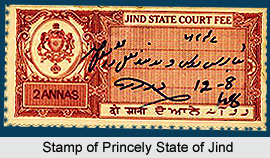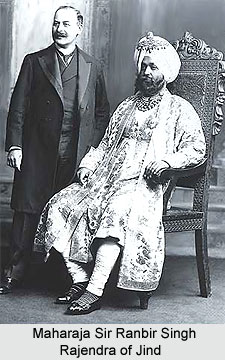 The Princely State of Jind was one of the prominent 13 Gun Salute States of India that were administered by native rulers or Indian princes under the indirect control of the British Government of India. The state covered a total area of 1,299 sq miles and comprised of a total population of 361,812 in the year 1941. The native state of Jind was located in the southern Punjab and contained 9 extensively spread blocks of land. These were organised into 3 tahsils, namely, Dadri, Sangrur and Jind. The region of Sangrur was intermingled with the regions that belonged to the princely state of Patiala and the princely state of Nabha. The princely state of Jind was situated in the southeast of Sangrur and was completely bounded by the British territories. Dadri was the largest tahsil amongst the 3 tahsils, was located in Rajputana and Hariana, to the south of Jind. It was detached by the British territory of Rohtak and was bounded in the west by Loharu; in the southeast by Dujana; and in the south by the Narnaul district of Patiala. The Princely State of Jind was incorporated as a part of the Punjab States Agency.
The Princely State of Jind was one of the prominent 13 Gun Salute States of India that were administered by native rulers or Indian princes under the indirect control of the British Government of India. The state covered a total area of 1,299 sq miles and comprised of a total population of 361,812 in the year 1941. The native state of Jind was located in the southern Punjab and contained 9 extensively spread blocks of land. These were organised into 3 tahsils, namely, Dadri, Sangrur and Jind. The region of Sangrur was intermingled with the regions that belonged to the princely state of Patiala and the princely state of Nabha. The princely state of Jind was situated in the southeast of Sangrur and was completely bounded by the British territories. Dadri was the largest tahsil amongst the 3 tahsils, was located in Rajputana and Hariana, to the south of Jind. It was detached by the British territory of Rohtak and was bounded in the west by Loharu; in the southeast by Dujana; and in the south by the Narnaul district of Patiala. The Princely State of Jind was incorporated as a part of the Punjab States Agency.
History of Princely State of Jind
The Phulkian clan of the Sidhu Jat dynasty was the ruling family of the Princely State of Jind. The territory was founded by the descendants of Phul Haryana, under the support and security of the Sikh gurus Guru Har Rai and Guru Har Gobind. Phul Singh, the founder of the Phulkian Sikh dynasty was originally a Chaudhary in the south east part of Delhi. His descendants established 3 states namely Nabha, Patiala and Jind. Phul Singh had 6 sons namely Tiloka Ram Singh, Chunu, Rudh, Takhtmal and Jhandu. Tiloka was the eldest son of Phul a Jadon Bhati Rajput who founded the Phulkian clan. The 2 sons of Tilokha, Sukhchen and Gurdita became the rulers of Jind and Nabha respectively. After the death of Gajpat Singh, the second son of Sukhchen, his 2 surviving sons split his territory among themselves. The eldest son became the ruler of the region; while the youngest son established the Badrukhan estate. The native state of Jind was founded in the year 1763. Gajpat Singh reigned over the territory and held the title of Raja until 1789. He was succeeded by Bhag Singh who ruled till 1819. Later Fateh Singh rule over Jind state until the year 1822, and he was succeeded by Sangat Singh who ruled till the year 1834.
In the year 1860, a sanad was granted by the British administration to the Phulkian rulers with the authority to choose a successor to any of the 3 rulers who should die without a natural or adopted heir. After a period of vacancy for the next 3 years, Sarup Singh reigned over the princely state of Jind till 1864. He was succeeded by Raghubir Singh, who held the title of Raja-i Rajgan in the year 1881. Ranbir Singh succeeded him in 1887, he was declared as Maharaja in the year 1911. He was the last native ruler of the erstwhile princely state. Maharaja Ranbir Singh of Jind State held the official title of Colonel His Highness Farzand i-dilband Rasikh Ul-itikad Daulat i-englishia Raja i-rajgan Maharaja Sir Ranbir Singh Rajendra Bahadur.
The Princely State of Jind was honoured as one of the salute state of India with a gun salute of 13 guns. The native ruler of the state took charge of the administration and supervision of the region. A Representative Assembly was also established with 45 members and 36 of these members were elected. The Maharaja of princely state of Jind exercised plenary judicial powers, which also included the right to impose capital sentences on the people of the state, without reference to the British authorities. Jind state retained the right to mint its own currency and was ranked third amongst the Punjab states.
 After the Partition of India in the year 1947, the last ruler Colonel His Highness Farzand i-dilband Rasikh Ul-itikad Daulat i-englishia Raja i-rajgan Maharaja Sir Ranbir Singh Rajendra Bahadur, who was the seventh of his line, acceded his state to the newly formed Union of India, also known as Dominion of India in 1948. The former state of Jind was incorporated as a part of the Patiala and East Punjab States Union. At present, the town and district of Jind form a part of state of Haryana, India.
After the Partition of India in the year 1947, the last ruler Colonel His Highness Farzand i-dilband Rasikh Ul-itikad Daulat i-englishia Raja i-rajgan Maharaja Sir Ranbir Singh Rajendra Bahadur, who was the seventh of his line, acceded his state to the newly formed Union of India, also known as Dominion of India in 1948. The former state of Jind was incorporated as a part of the Patiala and East Punjab States Union. At present, the town and district of Jind form a part of state of Haryana, India.
Rulers of Princely State of Jind
The chronology of the Princely State of Jind is listed below-
* Raja Gajpat Singh (1763- 1789)
* Raja Bhag Singh (1789- 1819)
* Raja Fateh Singh (1819- 1822)
* Raja Sangat Singh (1822- 1834)
* Interregnum (1834- 1837)
* Raja Sarup Singh K.C.S.I (1837- 1864)
* Raja I-Rajgan Raghubir Singh (1864- 1887)
* Colonel His Highness Farzand i-dilband Rasikh Ul-itikad Daulat i-englishia Raja i-rajgan Maharaja Sir Ranbir Singh Rajendra Bahadur (1887- 1948)
* His Highness Maharaja Rajbir Singh, 8th Maharaja of Jind (1948)
* His Highness Maharaja Satbir Singh



















